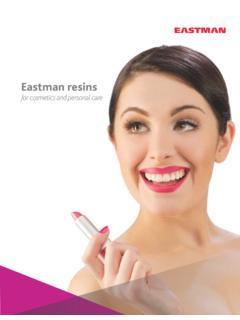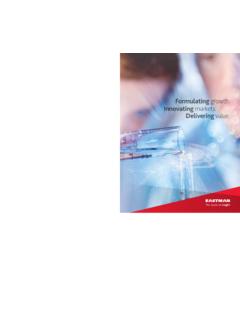Transcription of GN-424F Eastman Solventborne Adhesion …
1 1 Eastman Solventborne Adhesion promoters for difficult-to-adhere-to substratesIntroductionPolyethylene, polypropylene, and thermoplastic polyolefin (TPO) plastics are used in applications such as automotive parts, appliances, toys, containers, other molded items, and packaging films. To decorate and/or protect products made of these plastics, it is often desirable to apply a coating or to print an aesthetic design on the plastic to untreated plastic parts can be achieved by using Eastman Adhesion promoters as part of a primer or by formulating a one-step topcoat containing the Adhesion promoter. Some other plastics such as PPO and nylon and nonplastic surfaces including aluminum and galvanized steel can also be made more receptive to inks and coatings using Eastman Adhesion to automotive and general industrial plastic products requires resistance to a variety of severe environmental conditions, including exposure to gasoline, acid rain, chemicals, and humidity.
2 Eastman Adhesion promoters are particularly useful in ensuring the Adhesion properties of coatings under these severe environmental graphic arts and inks applications, Eastman Adhesion promoters provide additional properties such as fast dry and enhanced and benefits Promote Adhesion to polypropylene, polyethylene, TPO, and other plastics Useful for one-step systems or primer formulas Useful for inks and coatings Promote Adhesion to aluminum and galvanized steel Available in solution or powder form22 Eastman Solventborne Adhesion promoters for difficult-to-adhere-to substrates (Continued}Table 1 MarketsMarketAdhesion promoter AutomotiveGeneral industrialGraphic arts AdhesivesEastman CP 730-1333 Eastman AP 550-13333 Eastman CP 343-133 Eastman CP 164-133 Eastman CP 343-33333 Eastman CP 515-23333 Eastman CP 153-2333 Table 2 Eastman Solventborne Adhesion promoter performance selector)
3 ChartApplicationSubstratesPerformance properties and attributesEastman Adhesion promoterUsed in primerUsed in coating TPOa PPb PEcNon-olefin plasticsd MetaleHumidity resistanceFuel resistance CompatibilityCP 730-1 20% in xylene, Aromatic 10033 333AP 550-1 25% in xylene, Aromatic 10033 33CP 343-1 25%, 40%, 50% in xylene 100% solids33 333CP 343-3 25%, 50% in xylene33 3 333CP 515-2 40% in xylene, toluene, Aromatic 1003 3 333CP 153-2 25% in xylene33 Legend:ExcellentGoodAverageFairPoorLegen d:ExcellentGoodAverageFairPoorLegend:Exc ellentGoodAverageFairPoorLegend:Excellen tGoodAverageFairPoorLegend:ExcellentGood AverageFairPoorLegend:ExcellentGoodAvera geFairPoorLegend:ExcellentGoodAverageFai rPoorLegend:ExcellentGoodAverageFairPoor Legend:ExcellentGoodAverageFairPoorLegen d:ExcellentGoodAverageFairPoorLegend:Exc ellentGoodAverageFairPoorLegend:Excellen tGoodAverageFairPoorLegend:ExcellentGood AverageFairPoorLegend:ExcellentGoodAvera geFairPoorLegend:ExcellentGoodAverageFai rPoorLegend:ExcellentGoodAverageFairPoor Legend:ExcellentGoodAverageFairPoorLegen d.
4 ExcellentGoodAverageFairPooraTPO = thermoplastic polyolefinbPP = polypropylenecPE = polyethylenedNon-olefin plastics = nylon, PPE/PA, ABSeMetals = polished aluminum, galvanized steel, and contaminated steelLegend:ExcellentGoodAverageFairPoor 3 Eastman Solventborne Adhesion promoters for difficult-to-adhere-to substrates (Continued}Table 3 Typical propertiesa of Eastman Adhesion promotersSpecific gravity @ 25 C (g/ml)Weight per gallon (lb/gal) Chlorine wt% Gardner colorSoftening point range, CFlash point C (Toc) Eastman CP 730-1 Adhesion promoter20% in 234 26b20% in Aromatic 234 26bEastman AP 550-1 Adhesion promoter25% in 27b25% in Aromatic 47bEastman CP 343-1 Adhesion promoter25% in 237 2740% in 238 2350% in 238 28100% (@ 23 C) (@ 23 C)18 23Lt.)
5 Tan powder80 95274 Eastman CP 343-3 Adhesion promoter25% in 326 7 2350% in 3211 27 Eastman CP 515-2 Adhesion promoter40% in 323 2840% in 323 540% in Aromatic 327 41 Eastman CP 153-2 Adhesion promoter25% in 2512 15 30aEastman makes no representation that the material in any particular shipment will conform exactly to the values Closed Adhesion promoters with low chlorine levels are soluble in Aromatic hydrocarbons such as xylene, toluene, and Aromatic 100. Cyclic hydrocarbon solvents such as methylcyclohexane and ethylcyclohexane can be used to dilute them. Low chlorine materials are not soluble in aliphatic hydrocarbons, esters, ketones, or alcohols but can be diluted, as supplied, with some long-chained ketones and esters, such as methyl amyl ketone and n-butyl propionate.
6 When diluting them with long chain ketones and esters, the solutions may appear hazy. This haze does not appear to affect the product s ability to promote Adhesion to PP or CP 343-3 Adhesion promoter and CP 515-2 Adhesion promoter are high-chlorine CPOs that have a greater tolerance for esters and ketones as shown in Table 4. Their greater tolerance for esters and ketones makes them easier to incorporate into topcoat 4 Solubility properties of Eastman Adhesion promotersa Diluted 5% Adpro with: Xylene Toluene Aromatic 100 HeptaneTetra- hydro-furan Ethyl acetate n-Propyl acetate n-Butyl acetateMethyl ethyl ketoneMethyl n-amyl ketone Ethyl alcoholEastman CP 730-1 Adhesion promoter20% in xylene333x3xxxxxx20% in Aromatic 100333x3xxxxxxEastman AP 550-1 Adhesion promoter25% in xylene333xxxxxxxx25% in Aromatic 100333xxxxxxxxEastman CP 343-1 Adhesion promoter25% in xylene333x3xxxxxx40% in xylene333x3xxxxxx50% in xylene333x3xxxxxx100%333x3xxxxxxEastman CP 343-3 Adhesion promoter25% in xylene333x3333 3 3x50% in xylene333x3333 3 3xEastman CP 515-2 Adhesion promoter40% in xylene333x3x3x3
7 3x40% in toluene333x3x3x3 3x40% in Aromatic 100333x3x3x3 3xEastman CP 153-2 Adhesion promoter25% in xylene333x3xxxxxxLegend: 3 = reducible to 5% nonvolatile Adhesion promoter x = not reducible to 5% nonvolatile Adhesion promoteraSolubility of Adhesion promoter, as supplied, diluted to 5% nonvolatile in a variety of Solventborne Adhesion promoters for difficult-to-adhere-to substrates (Continued}5 Eastman Solventborne Adhesion promoters for difficult-to-adhere-to substrates (Continued} Solventborne CPOs storage and handlingEastman CP 730-1, AP 550-1, CP 343-1, and CP 153-2, used predominately as primers, have limited solubility and thus provide excellent redissolve resistance.))
8 Because of limited solubility, solutions of these Adhesion promoters may become hazy, partially precipitate from solution, or gel with time on exposure to low temperature. Should any of the above conditions occur, warming the contents to approximately 38 49 C (100 120 F), while keeping away from sparks and open flame, with mild agitation, will generally return the product to its original condition. Static electricity with associated hazards can build up during handling or mixing nonpolar solvents such as xylene or toluene. It is the users responsibility to determine the suitability of this information for their specific operations and to take all necessary precautions to ensure the safety and health of their employees and protection of the of CP 730-1, AP 550-1, CP 343-1, and CP 153-2 solution products near 25 C (77 F) will minimize haze and gel formation.
9 Storage above 50 C (122 F) may affect product CP 730-1 Adhesion promoterEastman CP 730-1 Adhesion promoter is designed to be the active component in automotive Adhesion promoter primers used to ensure Adhesion of color coats and topcoats to polypropylene (PP) and thermoplastic olefin (TPO) plastics for exterior and interior applications. Eastman CP 730-1 Adhesion promoter provides excellent Adhesion properties for all typical basecoat chemistries. Adhesion promoters built around CP 730-1 exhibit superior gasoline and humidity resistance, which are required for the newer, high modulus TPOs being used today.
10 Excellent Adhesion performance is also achieved on other difficult substrates such as aluminum, galvanized steel, cold rolled steel, and difficult-to-adhere nonolefin plastics such as nylon, ABS, and other engineering plastic blends. Eastman CP 730-1 Adhesion promoter is available at 20 wt% solids in Aromatic 100 or in xylene. CompatibilityTable 5 shows the compatibility of Eastman CP 730-1 Adhesion promoter with a variety of coating Solventborne Adhesion promoters for difficult-to-adhere-to substrates (Continued} Sample # Duramac HS 207-2706a Polymac HS 057-5776a Polymac HS 220-2010a Polymac HS 57-5789a Desmophen 670A 80b Paraloid AU608Xc Acrylamac 232-1700a Epon 828g XyleneEastman CP 730-1 (20% in A-100)d 9:1 1.)









